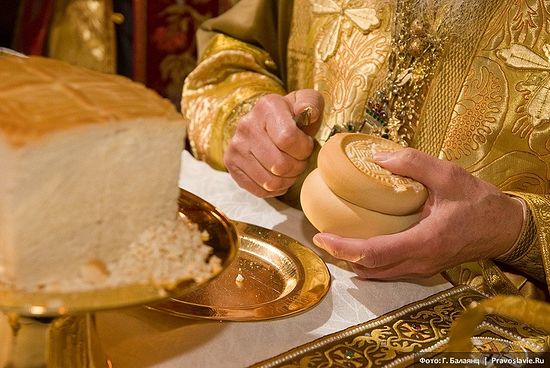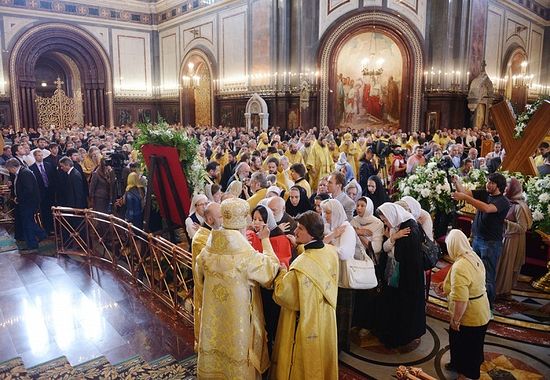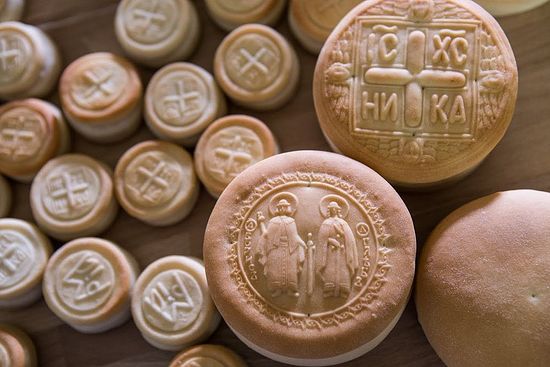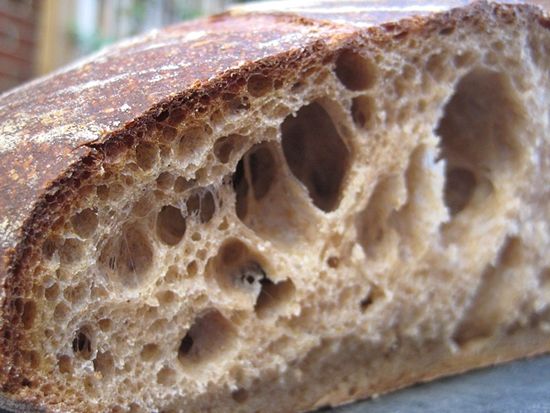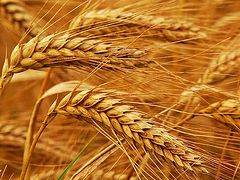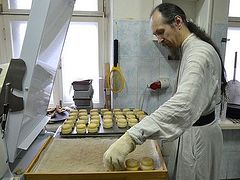“And Jesus said unto them, I am the bread of life: he that cometh to me shall never hunger; and he that believeth on me shall never thirst.”
John 6:35
In our daily life, bread satisfies hunger, strengthens us for our daily tasks, and reminds us of its spiritual potential, for during the Divine Liturgy, bread becomes the Body of Christ, the Bread of Life, both in symbol and in actuality, supporting us in the activities of our spiritual life.
The Holy Scriptures abound in references to bread, ranging from its nourishing the physical bodies of the faithful five thousand who had come to hear Christ’s preaching (Mark 6:41-42), illuminating the essential role of Grace in miraculous healings (Mark 7:27), to its culminating and preeminent role in granting salvation to the world (John 6:33; I Corinthians 11:24). Bread was Christ’s means to rebuke Satan when He reminded the devil while being tempted in the wilderness that “one does not live by bread alone” (Matthew 4:4), but Christ also taught His disciples to ask of their Heavenly Father their daily bread (Matthew 6:11).
Christ, being full present in the Bread of Holy Communion, through His Holy Body (Bread) unites all Orthodox Christians in one unity, when they approach the Holy Chalice “with fear of God, faith, and love.” (Divine Liturgy of St. John Chrysostom).
However, as bread can be a means to salvation, it can also become the mechanism of separation, as seen when, on the night of his betrayal of the Savior, Judas Iscariot took bread, dipped it into the common dish and announced his departure from Christ and from the company of the Apostles (Mark 14:20). Likewise, it is through our participation in, or rejection of, Communion of the Heavenly Bread, that the earthly boundaries of the Orthodox Church Militant, the Body of Christ, are drawn. Those who receive Communion unworthily commune unto their condemnation (I Corinthians 11:26-32). Those who receive Communion in good conscience, thereby fully affirming the teachings of the Orthodox Church, are members of the Holy Church, whereas those that separate themselves from the Truth through heresy or schism or, of their own volition are long separated from Holy Communion, separate themselves from the Church of God. Those who long abstain from the Divine Mysteries become “the prey of the spiritual wolf” (see St. John Chrysostom’s prayer before Holy Communion “That I may not by much abstaining from Thy communion become the prey of the spiritual wolf…”).
Christians must receive Holy Communion on a regular basis. It is the most powerful way of expressing to God our thanks for His redemptive sacrifice “for us men and for our salvation.” By abstaining from the Body and Blood of Christ, a Christian demonstrates that he is no longer a member of the Body of Christ.
Without Christ, there is no salvation. Christians are called not only to work toward their salvation, but to Be perfect as your Father in Heaven is perfect… (Matthew 5:48), a goal that is accomplished through frequent participation in the Divine Mysteries of Christ, the source of life and spiritual strength for the Faithful.
***
The Orthodox Church’s use of leavened bread is rich in symbolism. St Mark of Ephesus emphasized (in the disputes at the Council of Florence in 1439), that the action of yeast on the dough bore witness to the presence in bread of “the fullness of life,” and that it symbolized the confluence of two natures, the Divine and the human, in the one person of our Lord Jesus Christ. The use of unleavened bread was considered a manifestation of Monophysitism, a heresy that confessed that there was but one nature, the Divine, in Christ. St. Mark considered unleavened bread to be “lifeless,” or a “dead sacrifice,” unfit for Divine service.
The Resurrected Lord, always present in the Divine Liturgy, through His transubstantiation (merging the Divine and human natures) makes it possible for us, mortal and fallen away from God, to partake of His Divine life. According to St. Nicetas, a contemporary of St. Symeon the New Theologian and one of the authors of the Philokalia, “partaking in the nature common to us [the physical], we are also able to partake of the Divine nature contained in the Eucharist.” To put it another way, “…as we lack a Divine nature in ourselves, we are unable to become partakers of it, unless we partake of it through Christ, who united it [the Divine] to that of which we are able to partake—namely human nature…” (Break the Holy Bread, Master, by Priest Sergei Sveshnikov).
To emphasize this understanding, St. Irenaeus of Lyon writes (ca. 180 AD), “For the bread, which is produced from the earth, when it receives the invocation of God, is no longer common bread, but the Eucharist—consisting of two realities, earthly and heavenly. So also our bodies, when they receive the Eucharist, are no longer corruptible, having the hope of the resurrection to eternity.”
It is for this reason that in the Epiclesis (the invocation of the Holy Spirit) during the Eucharistic canon in the Divine Liturgy of St. John Chrysostom we “entreat” God to “send down Thy Holy spirit upon us and upon these Gifts set forth.” First upon us, only then upon the Gifts: the same action of the Holy Spirit that is to make the bread into the Body is to make the Faithful into the Body; and in the same way that we remain fully human as we enter into the Body of Christ, the bread also maintains its nature consubstantial to our humanity as it too becomes the Body of Christ (Break the Holy Bread, Master by Fr. Sergei Sveshnikov)
A loaf of bread, containing many grains, is one loaf, as we are many peoples, incorporated into one Holy Church in Christ—the Body of God. Armed with this understanding, let us all deeply reflect, be thankful to God, and prayerfully prepare to receive the Mystery of our salvation, accomplished through the Bread of Life that is Christ.
From Parish Life, a Monthly Publication of Russian Orthodox Cathedral of St. John the Baptist, Washington, D.C., September, 2015

